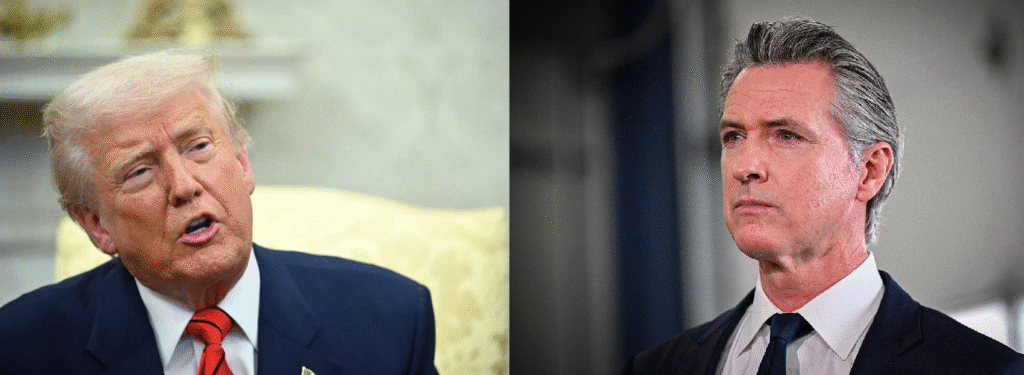Today, the rapidly escalating clash between former President Donald Trump and California Governor Gavin Newsom crossed a new constitutional frontier.

When asked by a reporter if Border Czar Tom Holland should arrest Governor Newsom , Trump said plainly: “I would do it if I were Tom”. The question was in response to Newsom daring him to arrest the governor over California’s noncooperation with federal immigration enforcement in Los Angeles.
Newsom fired back immediately on X, stating, “This is a day I hoped I would never see in America. … this is an unmistakable step toward authoritarianism”.
Meanwhile, National Guard troops—2,000 strong—were federalized and deployed to Los Angeles in a move not seen since 1965, with an additional 700 Marines reportedly placed on standby. California’s leadership responded by filing suit, asserting the federal government circumvented the 10th Amendment and other legal safeguards.
What Would an Attempted Arrest Look Like?
For starters, Tom Homan would have no lawful authority to arrest an elected governor absent criminal charges and due process. Any attempt would require federal agents to violate California’s sovereignty.
A takedown attempt might involve ICE or DOJ agents serving a warrant—if Newsom could be charged with obstruction or felony “harboring.” But legal scholars are skeptical:
-
Courts would almost surely demand probable cause that Newsom personally impeded federal enforcement. Simply advocating policy or failing to comply is politically protected, not criminal.
-
The Supreme Court has upheld strong gubernatorial prerogatives, including in the Insurrection Act and federal‑state conflicts.
-
No indictment, no arrest. And no constitutional or statutory authority presently exists to criminally detain a sitting governor over these actions.
Thus, any real move toward arrest would almost assuredly lead to immediate injunctions from federal courts, stay orders by appellate judges, and sweeping constitutional challenges.
Legal Experts Raise Red Flags
Some law experts have raised questions surround the legality of such a move. Robert Chesney, a constitutional law professor at the University of Texas, told Time that criminal charges require “a clear and direct act of obstruction, not merely disagreement with federal policy.” Jenna Ellis, former DOJ litigator, told Reuters: “Arresting a sitting governor would be unprecedented—and likely unconstitutional without a formal impeachment or removal process.”
What Would an Arrest Try Trigger?
A credible plan to arrest Newsom would likely unfold in stages:
-
Warrant issued by a federal judge for obstruction or harboring (petty or felony) based on alleged actions.
-
Service of process carried out by federal marshals or ICE agents.
-
Legal challenge filed immediately by California’s AG in federal court seeking an emergency injunction.
-
Judge’s temporary injunction, preventing arrest pending full hearing.
-
Appeal up to the Supreme Court if the case brings systemic conflict between state and federal governments.
If Trump somehow tried to bypass this legal process—say, via military involvement—the move would escalate into immediate legal and political crisis, triggering a constitutional showdown and fears of full-scale riots.
Could It Happen? Unlikely—but not impossible
Trump’s endorsement—“I would do it if I were Tom”—does not carry operational weight; it reflects political theater designed to stoke his base. Homan himself quickly walked back the comments, saying he was misconstrued. Still, paired with unlawful troop deployment, the rhetoric appears aimed more at intimidation than prosecutorial diligence. That said, it’s certainly not impossible that Trump, trying to make an example of Newsom, could choose to pursue an arrest, even if an eventual conviction was unlikely.
Political Fallout
The political stakes of Trump’s threat to arrest Governor Newsom are immense—and potentially far-reaching for both parties heading into the 2026 midterms. For Trump, the comments energize his core base, reinforcing his image as a no-holds-barred enforcer on immigration and border control. It also fits his broader campaign narrative of portraying Democratic leaders as obstacles to national security.
For Democrats, however, the threat offers a potent rallying point. Newsom’s swift and defiant response—daring Trump to “bring it on”—was echoed by top Democrats nationwide, many of whom framed the episode as a test of constitutional limits and the rule of law. It may galvanize turnout, particularly in progressive states where fears of authoritarian overreach remain high.
Moderate voters, however, may see the exchange as a disturbing example of escalating political theater with real-world implications. The threat to arrest an elected governor—without criminal charges or legal precedent—risks deepening distrust in federal institutions and further polarizing an already divided electorate.
If the situation continues to escalate, it could shape the political climate for months, if not years, to come—raising questions about executive power, states’ rights, and the future of American federalism.
Bottom Line
Trump’s threat to arrest a sitting governor could, if pursued, ignite one of the most intense constitutional and political crises of modern times. Courts would almost certainly intervene, and many in the public would surely seek to protest the move. Whether any of this moves beyond a couple comments to the press and social media posts, is yet to be seen.







